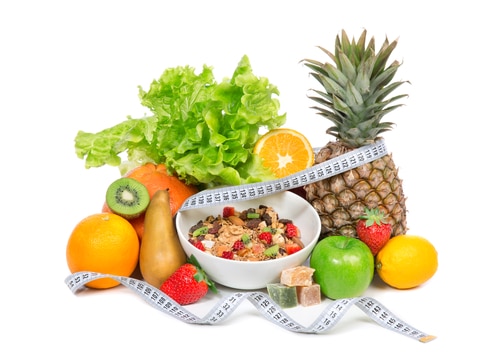
Satiety: Think Protein
Protein has the edge over carbohydrates and fat when it comes to boosting satiety. Protein impacts hormones that control appetite more favorably than a meal rich in fat or carbs. Plus protein keeps you full longer by stabilizing your blood sugar so you’re less likely to experience hunger pangs and cravings. You also get a slight metabolic advantage when you eat a high protein meal since it has a greater thermal effect than carbs or fat. This means your body has to expend more energy and calories to break it down. Both of these factors work in your favor when it comes to satiety and weight control.
Satiety: Make Your Meals Fiberlicious
Fiber is a dietary component most people don’t get enough of. Eating foods that are high in fiber has a number of satiety-inducing benefits. It slows down the rate at which food empties from your stomach. Fiber also forms a gel-like material that makes you feel satiated more quickly. According to research discussed on Nutraingredients-USA.com, it also activates gut hormones that signal your brain that you’re full faster. Plus, it reduces your glycemic response to a meal. This stabilizes your blood sugar and insulin levels so you stay full longer.
Adding more fiber-rich vegetables to your plate has two benefits. You get the benefits of the fiber and they’re low in calories due to their higher water content. Aim for 30 grams of fiber a day, and eat a good source of soluble fiber at every meal. Soluble fiber is abundant in vegetables, fruits, legumes, seeds, nuts, and whole grains.
Satiety: Add More Flavor to Your Food
Bland food is less satiating than food that’s packed with flavor. Ever notice how hard it is to eat a lot of hot or spicy food? Give your food more impact by adding chili peppers, curry, garlic or other strong spices to help control how much you eat. Some spices like capsaicin in chili peppers also boost your metabolism short-term when you eat them, which can work in your favor, although this effect is modest.
Satiety: Limit the Variety of Food You Put on Your Plate
Why do people eat so much at buffets? It’s not just because they’re trying to get their money’s worth, it’s also because there’s greater variety. Variety and novelty isn’t a good thing when it comes to your waistline. When you have fewer choices on your plate, you adapt to the monotony of eating the same flavors over and over and satiety sets in more quickly than if you have lots of options to choose from.
Of course, you have to weigh this against the benefits of eating a varied diet. With a varied diet, you’re more likely to get all of the vitamins, minerals, and nutrients you need as long as you choose wisely. When you add variety to your plate, make it foods with a high nutrient content like vegetables rather than empty calorie foods – and stay away from buffets.
Satiety: Don’t Drink Your Calories
Beverages don’t have the same satiety-inducing effects that solid food does, so unless they’re calorie-free you’ll get the sugar and calories from the beverage and still be hungry. On the other hand, thicker beverages or ones that are creamy are more satiating than thinner liquids, so a smoothie is more filling than a cup of fruit juice. Eliminate beverages that contain calories from your diet and sip water or unsweetened tea instead. When you’re pressed for time, a thick smoothie made with veggies, low-glycemic fruit, and Greek yogurt will fill you up because of its texture and provide you with a good source of vitamins, minerals, antioxidants, and protein.
The Bottom Line?
The composition of what you eat matters when it comes to satiety and the variety of foods available to you has an impact too. Keep these factors in mind when planning your meals so you’ll eat fewer calories and still feel satisfied.
References:
J Nutr. 2012 Jun;142(6):1149S-54S.
Am J Clin Nutr May 2008 vol. 87 no. 5 1558S-1561S.
Nutraingredients-USA.com. “Protein, Fiber and Flavor Key to Producing Satiety, Expert Says”
Eat Behav. 2006 Jan;7(1):1-14. Epub 2005 Jun 13.
Beverages Daily. “Sensory cues lift beverage satiety, ensure diners miss just desserts – study”
Related Articles By Cathe:
Hungry All the Time? How to Choose Foods That Will Keep You Full Longer
Does When You Eat Your Meals Impact How Much Weight You Lose?

